#genshin impact lore
Text
Genshin SAGAU except Reader is a lore fanatic
cw: lore dump, archon quest spoilers, side quest spoilers, etc
“ guys did u know that the Sea Ganoderma is actually souls of children who died young trapped and is forced to spend generations absorbing elements from the sand and sea as the form of punishment?? ” “ what the fuck your grace. ” Tighnari muttered.
“yelan, i know where u got ur jacket. ” “ o- oh, really, Your Grace? ” Yelan stuttered, sweat dropping. “ Yeah, i know u stole it from a Fatui Harbinger that was supposed to be a gift for the Tsaritsa and made some 'adjustments' to make it fit your style. ” you stated with a smirk, while yelan tries to hold in her cries because you rlly are a Divine Being, knowing everything about Teyvat.
Archon quest spoilers down ahead
“ Guys, I have a theory that the upside down Statue of the Seven and city the Traveler and Paimon saw are actually the correct way and that proves it because when I took a walk at Spiral Abyss when I went down I expected it to be pitch black but instead I'm met with the galaxy sky and a moon and possibly, Khaenri 'ah and Enkanomiya are the ones that are actually in the surface, while Teyvat is underground and yknow what? Scaramouche is RIGHT. The stars are fake the sky is fake everything is fake as we know of HAHAHAHAHAHAHAHAHA ” your maniacal laughter echoed through the Akademiya as many Researchers are baffled by this amount of information
“ Alhaitham, do you have a second? ” “ Of course, Your grace. What is it? ” “ Are you the Scarlet King ” “ ........ excuse me ”
“ WELL i noticed that the color of your eyes matches the Scarlet King's eyes, and your boots matches the color of the buildings of the Scarlet King's Civilization. A blue gem appeared when the Scarlet King sacrificed himself and it kinda looked like the gems at your back. And when you do your burst it looks REALLY similar to the Primal Constructs’ attacks, and the Primal Constructs are what's left of the Scarlet King's civilization. And at your chest it looks like it has the wings of an eagle, and your name literally means young eagle. What does this have to do with the Scarlet King? Well, at the Dunes I've ventured, I've seen murals and a figure with a bird head and it could possibly be the Scarlet King but it strangely reminded me of you!!! Plus, you know how to use the devices made by the Scarlet King, whereas the books and researchers at the Akademiya shows no information on how to properly use them. Pretty suspicious...... ”
and then theres alhaitham sweating his balls off on how the hell did you get that information.
“ guys, did you know that when Enkanomiya was plunged deep into the ocean, they created a fake sun called Helios to survive, right??? But actually, the nobles wanted more power. They wanted a puppet or ruler that they could easily control or manipulate. And WHO WOULD MAKE A GOOD CANDIDATE??? THAT'S RIGHT! A CHILD. AND THUS, BEGIN THE REIGN OF THE SUNCHILDREN. They were young and ignorant, obviously easy to be deceived and lied to. They were manipulated to commit heinous deeds. The first Sunchild was deceived to imprisoning his role model for life, aka isolated from everyone. The sunchildren were DESPISED by their own people, EVEN THE CARETAKERS ARENT ALLOWED TO SPEAK TO THEM. Knowing that the Sunchildren could realize that they were being manipulated, the nobles then introduced Rite of Solar Return. Now what the hell is a Rite of Solar Return??? Basically, when a Sunchild hits a certain age, they will be taken into the inner sanctum of Helios. The artificial Sun's high temperature could AND WOULD incinerate them alive!!!!! AND SOMEHOW, SOME HAVE SIMILARITIES WITH OUR CURRENT ARCHONS!!! Orupeusu had a talent for the lyre, aka the Anemo Archon. Risutaiosu made lifelike sculptures, like the Electro Archon. And Isumenasu would roam his country, AND EVEN HAD A SPEAR LIKE THE GEO ARCHON AT HIS GRAVE!!! HAHAHAHAHAHAHAHAHAHAHHAHAHA I AM A GENIUS ”
the fact that people would still listen to your rants about Teyvat but still be concerned about your mental health is hilarious
if you werent the Divine Being of All, they would've locked you up where no one can find you, you know
Dottore would like you tho
so that's good
#genshin impact#genshin impact x reader#genshin impact x you#genshin impact x gender neutral reader#genshin impact x male reader#genshin impact x female reader#yandere genshin#yandere genshin impact#yandere genshin x gender neutral reader#yandere genshin x female reader#yandere genshin x male reader#yandere genshin impact x gender neutral reader#yandere genshin impact x female reader#yandere genshin impact x male reader#yandere genshin cult au#genshin cult au#genshin sagau#sagau#genshin lore#genshin impact lore#genshin theories#genshin impact theory
6K notes
·
View notes
Text
People always rank either Ei or Zhongli (or both) above Venti in power rankings. Like, who is the strongest archon? There are always two answers: Morax or Beelzebul. Never Barbatos.
I like to think otherwise.
This guy has cut mountains with his winds and thrown them so far away into the sea, made winter disappear and turned Mond into what it is today: from a barren rocky land that used to be filled with snow and raging blizzards into this green plain field with gentle winds where agriculture is so much easier then it ever was back then. I don't think people of Old Mond could have ever imagined for Mond to turn into what it is today.
But he still calls himself weak. And people took that to face value. And some still do despite it being proven otherwise by Nahida.
Venti said that an archon derives their power from ruling over their nation. But Nahida denies this later and says that archons gain their power through the faith of the people.
Clearly, Venti lied to us.
And if we go by what Nahida said,,,, Every freakin person in Mond has faith in the Anemo archon. They sing praises of him despite not having been in the presence of their god for 5 centuries. He has a statue and a Cathedral (who else has that?).
So, Venti is Strong.
Remember his gnosis is in the shape of a queen chess piece? Queen has the most freedom on the board. Venti's ideals are freedom. And his element is anemo. Anemo is the free-est element out there.
He might as well suck the air out of your lungs if he so wants to. He governs over it.
My point is, Venti is overpowered.
And let's not forget how that little wind wisp gained archon hood.
It was his desire to protect that helped him into becoming a god. When the nameless bard died, he felt the need to protect whats left. To protect what his friend died fighting for.
And its a pretty cliche concept out their about how a hero grows stronger, in any story. Its their need to protect. Right?
And Venti still wants to protect Mond- despite him saying otherwise. He shows up everytime Mond is in danger. Whether directly or indirectly, he always helps out.
So here is what I think. The reason why he calls himself weak.
Its because he is so strong, strong enough to scare Celestia. So Celestia has put him on some sort of leash. He can't use his powers in it's entirety. There is probably some sort of seal.
So Venti is weak.
Because he can't use all of his powers. Because he is chained to Celestia's whim.
Venti is weakest of the seven because he is the only one who has some sort of leash on him.
The god of freedom, chained.
Plus, it can definitely not be a coincidence that the defiled statue was of Barbatos, out of all the seven. Chained, hanging up-side down and corrupted.
And the fact that the abyss order was going to use Barbatos (chained) statue to create a machine to "topple the divine thrones of Celestia."
None of that can be a coincidence. Knowing hoyoverse, it definitely isn't.
So yeah. Venti is definitely not weak. He just can't use the full extent of his powers as of right now.
Venti is strong, but also weak. If he isn't chained- he is easily the strongest.
He can slice the mountains and throw them far into sea- if Zhongli throws a big peice of meteor on him, venti should be able to cut it in half too. if he has all his power on him that is.
I really hate it when people call him weak just because he said so himself. Especially when it's been proven that we shouldn't take his words to face value.
He is not like our sweet little Nahida, people.
#also#i feel like we are going to see something about this in his second story quest#there is *always* lore drops when he appears.#however big or small#venti#barbatos#genshin barbatos#genshin venti#character analysis#genshin impact venti#genshin analysis#genshin impact lore#genshin impact#archon venti
273 notes
·
View notes
Text
The Traveler being around is probably good for Furina. In Marcel's trial, we see Melus and Silver speculate on why Furina's suddenly taking everything way more seriously--and they think it's either because the Traveler humiliated her, or because she's so embarrassed and horrified by pressing charges against an innocent.
In a way, I feel like the people of Fontaine kinda encourage Furina to act as she does--spoiled and immature, dumping responsibility on Neuvilette and the Oratrice. But she also encourages them to not question the justice system, by struggling so hard to put on a show and save face. It's something of a vicious cycle. The people treat her as a celebrity and only really expect her to amuse and reassure them, not actually DO anything. So she's encouraged to act like a bratty and spoiled child. But the Traveler being around is someone who's NOT impressed or amused by her--and, even better, they're someone she really, really does WANT to impress, who she greatly respects. The Traveler will treat Furina as a person and an Archon, and force her to take responsibility for her people and actions. 'Cause like, she sucks at her job and needs to either take responsibility or find a way to retire like Zhongli. But also I feel like she's probably kinda lonely.
Like. Venti and Zhongli are highly respected and beloved by their people, and are the most proactive and responsible with their roles, at least in the present day. They're also the most oldest of the Archons, so they are the most experienced. It makes sense.
Ei, Nahida, and Furina, though, all seem to be foils of each other to varying extents. While Zhongli and Venti rule their country from behind the scenes, the three younger Archons initially appear to be in positions of power and authority...but aren't really.
Ei has a great deal of power and authority, and is feared or respected by most of her people. But due to her grief over the losses of Makoto and her generals, she has given up responsibility and stopped caring what her people want. She orders Visions be collected and does the war against the Resistance, but she's not really...present, letting the Raiden Shogun and the Tenryou commission run things. She knows the Fatui are in Inazuma apparently, but doesn't seem to care. Only when the Traveler and Yae Miko beat/talk sense into her does she really start to act like a leader and try fixing her mistakes. Up until that point, Ei has been isolating herself.
On the other hand, the Akademiya were grieving Rukkhadevata so much that they forcibly rejected, isolated, and imprisoned Nahida. She did her best to interact with her people and help them when she could, but she wasn't really allowed to rule, and lacked the power and authority she needed to properly lead Sumeru. Largely, Nahida only needed more confidence, and to be believed in--she was already much more mature than Ei or Furina were.
Ei is treated as an Archon, but lacks the maturity of one. Nahida had maturity and a sense of responsibility, but people didn't treat her as an Archon until Rukkhadevata was erased from memory. Furina inherits the worst of both Ei and Nahida's positions and personalities. She lacks the maturity of an Archon, but also no one actually treats her as one. When the Oratrice malfunctions people turn to her for reassurances...but really, the Oratrice seems like way more of a God to them than she ever was. It's not Furina who is the final authority in the Court, it's the Oratrice.
Honestly, Furina might be what would've happened had Nahida lacked the maturity and wisdom she had, and been completely replaced by the Shouki no Kami. Aside from the lochfolk and the Pari, people in Fontaine don't grieve the Lord of Amrita like Rukkhadevata was grieved, but the people replaced their Archon with a machine that tells them comforting lies about how easy and straightforward Justice is, and their Archon helped them do so.
I feel like Furina must be a lonely individual, since she's dismissed by most in her country, and even other Archons likely find her unpleasant, annoying, or immature. She has some growing to do, too, but I hope that by not being impressed by her at all, and instead being blatantly annoyed by her, the Traveler can reach those parts of her.
#furina#focalors#genshin impact#genshin impact 4.0#genshin impact meta#genshin impact analysis#genshin impact thoughts#genshin impact lore#archon#venti#zhongli#ei#nahida
890 notes
·
View notes
Text
Venti’s Presence in Mondstadt and in Lore: A Comprehensive List
Barbatos is an Archon that does everything in secret and wants virtually no recognition for it. Desiring not to become like Decarabian, he "disappeared" so Mondstadt could be free and without a ruler, yet he has still done what he could to retain Mondstadt's peace. Here is a comprehensive list of everything of note that he has done.
Disclaimer: I may miss details. Some things such as character voice lines about Venti, save for Xiao’s are largely omitted. All sources are present.
I. Wind Gliders
“The ability of wind gliders to glide is reliant first and foremost on the Blessing of the Anemo Archon. Of course, it’s also been intertwined with human engineering.”
Wings of Companionship
II. But I do not intend to make my readers think that we could do without archons. On the contrary, say, if Barbatos had not guided the warm monsoons to Mondstadt with his divine powers, would Mondstadt still be so bountiful as to produce the brews that it does?
The answer would be no. Mondstadt is an inland city and would have struggled to provide for itself if not for the grace of Barbatos. If we look back through history, we learn that Mondstadt is situated on a land that was once frozen, where the living conditions were harsh and brewing would be virtually impossible. It was the power of Barbatos that changed everything.
Along With Divinity: Prologue
III. The songs that had once flown joyfully in the wind were drowned by a venomous dragon [Durin]. In the wake of its earth-shaking footsteps, even the cries and the flames were ripped asunder. The Anemo Archon heard their agony, though he had refused to rule. But to protect his old friends' dream, and defend the wind-kissed fields of green,He woke from his long slumber anew, and with the sky dragon [Dvalin] in battle he flew...
Elegy For The End
IV. In ancient times, Barbatos softly strummed his lyre and summoned the pure thousand winds and songs. Charmed by the free-spirited winds and songs, Dvalin the high dragon descended and swore loyalty to him. Barbatos rejoiced in making a new friend, and entrusted the people of Mondstadt to Dvalin. And so, the wandering Anemo Archon and the Wind Dragon forged Mondstadt's dawn with their relationship.
Skyward Harp
V. On the cliff facing the eastern sea, the ancestors worshipped the masters of Time and Anemo together. The two are intimately related, as expressed in the saying, "Anemo brings stories while Time nurtures them." This bow tells the story of the pioneers and the hardships they went through.
Sacrificial Bow
VI. When Mondstadt was born anew, and the Church finally unshackled, the scriptures of the winds could bear no longer being confined to a shelf, and so the book took flight, left the Church's treasury and was gone. Like the winds of Mondstadt, and like the people of Mondstadt, it belonged to freedom and the winds. The elegant handwriting on the title page reads:
Children of the Anemo Archon, heed these words:
From the winds we have come, and with the winds we shall go.
Never, ever grieve for me.
'Tis but my flesh and bones which rest in the soil:
My soul has become one with the thousand winds.
When flowers bloom, when leaves sway,
That is me who sings the songs of freedom, of the winds.
Lost Prayer to the Sacred Winds: Scriptures of the ancient winds, passed from generation to generation among the observers of ritual in service of the Anemo Archon.
VII. The Skyward Atlas consists of 100,000 odes to a single cloud or wind and calling it by name. The cloud atlas gave form to the winds, and odes infused them with personality. The myriad formless winds are now friends and family in the eyes of Barbatos. Legends tell that in ancient times, Barbatos summoned the four winds with the original version. He thawed the snow, drove away vicious beasts, summoned rainfall, and created Mondstadt.He permitted the atlas to be shared and copied among the people, giving it the name of Cloud Atlas.
Skyward Atlas
VIII. In the days of the ruling aristocracy, the Church that revered the Anemo Archon was once split in twain by a schism: On one side stood the clergy, who ate at the lords' table, and overturned the archon's statues with them even as they wrote songs and hymns of praise. On the other stood the saints, who held no clerical office, and who walked the streets, the wine cellars, and the world beyond the walls. These saints drank cheap moonshine, blessing the slave and the plebeian with the original holy manuscripts that circulated amongst the people and with words that the wind brought to them.
And while they did so, they penned forbidden songs and poetry.
When the gladiator from a foreign land [Vennessa] arose together with the re-awakened Anemo Archon and raised the banner of rebellion, the aged saint known as the Nameless Shepherd mobilized the true adherents of the Church of Favonius.
Song of Broken Pines
IX. When he opened his eyes, he was in the sky above a mountain swept by roaring snowstorms, the green, tranquil land had already been painted crimson by fire and blood,and the song of that sky-blue bard's lyre was almost drowned in the howling tumult,and that bejeweled, lovely dragon, like a tender lover, had now pierced his neck through with its sharp fangs.
"Farewell, Mother! My journey is ended. I shall sleep beneath this white, shining silver... and perhaps this, too, is good. Farewell, O lovely bard! And farewell, O lovely dragon! Would that we had met in a different time and place, to meet, to sing and dance together!"
So he thought most sincerely as he lay dying.
Durin (Dragonspine Spear)
X. They say that a region's character follows that of its archon, and that this holds true both for the people and the land itself, but was it the unfettered archon who bestowed a love of freedom and wine upon the land and people amidst conflict? Or was it the people who nurtured the Anemo Archon's love of freedom as they pined for it amid the howling wind and frost?
This is a question that can no longer be answered.
Freedom Sworn
XI. Twenty-six hundred years ago was the era of Mondstadt's most ancient inhabitants. They swore a solemn oath, after the new Anemo Archon descended and reformed the world:
"For Mondstadt, as always. For the verdant plains, for the hills, and for the forests of Mondstadt. May they continue to flourish, as always."
"For Mondstadt, as always. For the everlasting freedom of Mondstadt from the blizzard and the tyrant, whose coldness and oppression are one and the same."
Royal Longsword (Refers to Gunnhildr Clan & the oath to protect Mondstadt.)
XII. Ludi Harpastum
Ludi Harpastum was established in commemoration of how Barbatos, the Anemo Archon, taught his people to brew wine and live freely. It was a festival meant for all people to enjoy. However, by the time of Vennessa's rebellion a thousand years before Genshin Impact's main story, Barbatos had long departed to avoid becoming a tyrant like his predecessor, while the aristocracy that ruled Mondstadt grew corrupt and abused their power.
The event turned into a mockery of what it originally was. It became an event enjoyed only by the wealthy elites. The head of the Lawrence Clan, the foremost clan among the aristocracy, cared not for the enjoyment of the people and canceled all the games, leaving only the climax of the harpastum. However, only Lord Lawrence's son, Barca Lawrence, had the right to touch that harpastum. Anyone else who dared even approach the ball would immediately face torture. Furthermore, Barca was also given the rights to take the maiden who will throw the harpastum home.
Barbatos awakens during the climax of the Ludi Harpastum in the manga and seizes the Harpastum.
Genshin Impact Manga
XIII. The Letter in the Chasm
Not as if I were to be outfitted as that guardian of Khaenri’ah,
Not as if my destructive self were made to be the lyre of Barbatos,
Not as if I were meant to soar like a Pegasus,
Not if I were the swift, snow-white pair of Morphes,
Add these to the feather-footed and the winged,
And likewise, call for the swiftness of the winds,
And though you should harness these, friend, and offer them to me,
Yet I should be tired to the bone, and worn away by frequent faintness,
My friend, while I would search for you,
The heavens fall to pieces,
And falsehoods collapse.
Mysterious Letter obtainable after completing The Chasm related Archon Quest(s) & World Quests (Information gathered by CatWithBlueHat)
It is important to note that each player who finished these quests only received one line of this letter in Abyssal Language, indicating this is a bigger part of something and made to be very secretive and hard to decipher if not for the efforts of players to translate it.
XIV. The Hexenzirkel
“Once upon a time, it even challenged the Anemo Archon himself, but he replied: “Let us make music, not war, and resolve our conflicts through song.”
Alice, The Mage’s Tea Party (Windblume’s Breath)
XV. Waterborne Poetry
“A soft breeze beckoned me unto a spring. “Sleep, weary wanderer. Your journey is over. May the dancing petals sweeten your slumber.”
Callirhoe, who recalled her journey to Springvale (Waterborne Poetry event)
XVI. Presence as a significant figure to Xiao
He longs for a day to come when he will wear the mask and dance — not to conquer demons, but to the tune of that flute amid a sea of flowers.
Barbatos appears as a cameo in Yakshas: The Guardian Adepti, playing the Dihua Flute. It suggests his music is powerful enough to suppress Xiao’s Karmic Debt. He also has a line for Barbatos indicaing he knows who he is, but cuts himself off.
Yakshas: The Guardian Adepti & Xiao: Mask (Namecard)
Other things to note:
As of Version 4.3 Mondstadt is the only nation that does not suffer from any “filth” that needs to be purged either by a Sacred Tree or otherwise. The battle that took place 500 years ago with Durin did not affect the nation in any way, instead, Durin died on Dragonspine which was already affected by the Skyfrost Nail and is an inhabited land that only Adventurers see as an area to explore. No one lives there. Even with the presence of his “heart”/”core” still beating, it would forever lie in the frozen wasteland unless someone were to deliberately disrupt it.
There are no storms in Mondstadt. Vind, one of the Sisters/Storm Watchers, says that she hopes she never has to do her job.
A large amount of npc’s around Mondstadt, especially in the area of the Anemo Archon statue, revere Barbatos and speak highly of him
It is important to note that during the second rebellion, Barbatos also forged Rex Lapis’ signature to dismantle the Aristocracy, indicating he would go to such lengths to establish freedom for the nation.
Barbatos’ voiceline about Albedo suggests that he knows close to “everything” about him, especially about his fear of “destroying Mondstadt.”
In addition to the above, Barbatos contradicts himself: “Ah, never mind! What goes on within Mondstadt's walls is up to Mondstadt's people to deal with!” Except that twice when the people cried out for help, he awoke to help them and has actively been helping Mondstadt with no recognition. From liberating Mondstadt to helping an Oceanid, this line will not hold any weight in any argument that suggests that Barbatos does nothing for Mondstadt.
Barbatos was already attempting to purge the Abyssal corruption from Dvalin prior to the Traveler’s appearance.
There is irony in Diluc and Jean finding out Barbatos’ true identity considering both the Ragnvindr’s and the Gunnhildr’s were primary protectors of Mondstadt.
The Skyward Atlas suggests Barbatos was originally a catalyst user while Amos’ Bow suggests he changed his weapon to a bow to honor Amos’ memory. He uses Der Frühling (E Skill) in a way a catalyst user might.
His appearance as his dear friend, the Nameless Bard is to honor his memory for the skies, bright sun and birds he could never see. To honor the songs he could no longer play.
144 notes
·
View notes
Text
"Oh Scaramouche should be electro, not anemo! Why would they do that?"
Y'all aren't understanding the symbolism behind it. Electro has been correlated with him through the entirety of him being a puppet. Through Ei, and through the Fatui. Electro has been with him when he has been lost, abandoned, and since he's been a puppet.
With anemo, related to the GOD OF FREEDOM, it's showing that he is now free from the clutches of being a puppet. He's now his own person on his way to create his own path, not one forged by a power hungry military powerhouse. He's free now, no longer chained to the ones that used him.
#sweethoneyfruit talks#scaramouche x reader#genshin men x reader#genshin impact 3.1#genshin impact 3.2#genshin lore#genshin impact theory#genshin impact lore
1K notes
·
View notes
Text
[4.0]: A Theory On Rhinedottir, Alchemy, and the Meaning of Sin
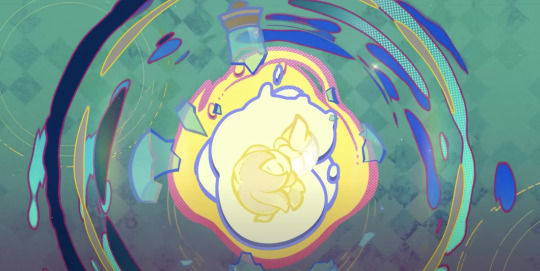
“One thought may end all calamity, and there will always be thoughts that may transcend time.” -The Meaning of Aeons
“Separate the dust in the flames with joy, and extract the exquisite from the crude. For all in the universe comes from a single source, and all things may be derived from a single thought.” -Cinnabar Spindle
I’ve been wanting to do some Rhinedottir speculations for a while. With the new Ancient Colors world quest in Fontaine, I think now is a good time to propose a theory about this mysterious member of the Hexenzirkel, her approach to alchemy, and the reason she is a “sinner,” especially within the context of one of the Archon Quest’s central questions: what does it mean to be “born with sin”?
SPOILERS: Up to Act II of the Fontaine AQ (just Primordial Sea stuff), and Ancient Colors.
Although Rhinedottir is never mentioned by name in Ancient Colors, all of the signs of her are there: Mamere’s identity as an artist, Elynas’ otherworldliness and similarities to Durin, and the differences between the Melusine’s perception of the world and our perception of it (or their aesthetics, which we will touch on later). Ancient Colors is trying to remind us of Dragonspine and, if you were playing during this time, Shadows Amidst Snowstorms, and I believe it is doing so because it is key to the secret of the Primordial Sea and the prophecy of Fontaine.
We’ve heard Rhinedottir’s perspective only twice so far, and that was in the Windblume festival from this last year and in Cinnabar Spindle’s lore. Though we still don’t know much about her, she does identify herself as a “mother” of many children, and that she is raising the only son she has left. This, of course, is Albedo.
We also know that she is considered a "sinner" at the center of the Cataclysm who unleashed "an army of shadowy monsters" onto Teyvat, but we have very little grasp of what exactly is meant by "sinner," and what if any consequences this label has had on her since then. Although every Hexenzirkel witch will undoubtedly be very important to uncovering the truth of Teyvat, Rhinedottir presents a particularly interesting case as the only one whose activities may have caused cataclysmic destruction, as opposed to Alice's general mischief and strange sense of humor.
It’s almost nothing to go off of, but I hope to demonstrate in this speculative theory that it’s more than enough to arrive at some answers.
Psychoanalysis 101, Round 2
To better explain what Durin, Elynas, and Rhinedottir’s other children are, we need to use an analogy rooted in Freud’s psychoanalytic theory of dream interpretation. This is a super TL;DR version of it and way oversimplified, but if you’re interested I wrote a more detailed theory about the significance of dreams in Genshin that has a full explanation of it there. (Also, it should be said that these were just Freud’s theories, please do not take any of the following as an accurate description of the human psyche and how it works. We are just having some fun for the sake of media analysis.)
Freud thought that dreams are the mind’s means of expressing unfulfilled wishes, and that the psychological purpose of dreaming is to “fulfill” those wishes. In A General Introduction to Psychoanalysis, he gives an example of this through a little girl’s dream where she was sailing on a lake: this dream was born out of an unfulfilled wish in her waking life, where she had to stop sailing on the lake despite wishing to continue. Hence, “I wish to sail on the lake” becomes “I am sailing on the lake” through the dream.
Further, Freud thought these unfulfilled wishes are “forgotten” in our unconscious mind when we are awake, censored by the ego to protect our conscious mind, but that at night this censorship is weakened. This is what allows a dream to occur while we sleep.
These unfulfilled wishes are often more complicated than a childish wish to keep sailing on a lake. Think about it this way: a wish is, at its core, a thought in our head, or a desire. What do we do with the thoughts we don’t like, the ones that are unbecoming of us or are unacceptable to fulfill?
We deny them.
Specifically, we repress them into the unconscious, where they are forgotten. Thing is, even if we temporarily forget these thoughts, they won’t just disappear from existence - they fester in the unconscious, waiting to be expressed. The dream, therefore, is the unfulfilled wish/repressed thought’s attempt to cross the boundary from the unconscious mind into the conscious mind - to be acknowledged, or indeed remembered.
“Unfulfilled Wishes”
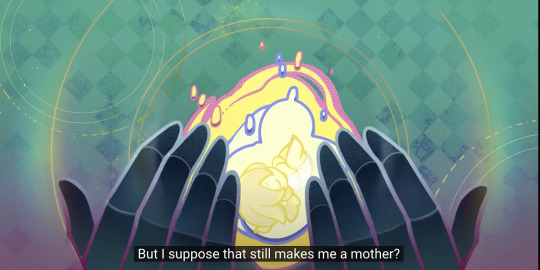
Making sense so far? If so, try to think of Teyvat like this: everything that is visible, everything above ground that the light touches and that can be perceived is like the ego and conscious mind. All of these things are what you’re aware of, things that you “know” and can make sense of, things that you understand, things that fit into rules and laws and order.
Now, think of everything in Genshin that is “unseen” and “unknown”: the Abyss, the spaces underground, forbidden knowledge, things that are “not from this world,” from beyond the firmament…these are like things from the unconscious mind, the repressed thoughts that we deny in ourselves because they may reveal a truth we are unwilling to face. These things are comparatively chaotic in nature, things we’d rather avoid, or things that we wish to forget.
We know that Elynas’ and Durin’s bodies are composed of matter that’s foreign to Teyvat, and that this is a major reason why they are incompatible with Teyvat and cause its destruction. This would make them more similar to a repressed thought, something that we don’t understand or know, and attempting to understand it destabilizes our sense of self, our “truth.” It follows that their home, the Abyss, is most similar to our unconscious mind, and Teyvat is most similar to our conscious mind.

Elynas: Before I was born, I floated in the cosmic darkness. It was cold there, and lonely. I was so sad, then, and I would often cry.
So, as their mother, who or what is Rhinedottir in this analogy? Well, we can be a lot more specific than calling her a “sinner.” In fact, she’s a dreamer, and alchemy is the medium through which she “dreams”:
This was a story from long ago...
Unborn life, unfulfilled wishes,
Tragic dreams at the edge of the universal darkness that could never come true,
Indwell my body, and descend unto this world.
Then, my lovely children,
Like rainwater flowing into creeks, and plants growing towards the sun,
Go unto a lovely place, and display your own beauty there with pride.
This is a memory, a memory that a child named Durin had of his mother…
"Thank you, Mother, thank you."
"You gave me wings to soar and a mighty form."
"Mother, I wish to go to a land of lovely songs,"
"I will tell them about you, Mother, and about everyone else."
"I shall tell them that the place where I was born is beautiful."
-Festering Desire
Rhinedottir’s children, then, are like thoughts or ideas that she is bringing to life, or “making conscious,” by moving them from the Abyss to Teyvat. It may even be the reason why the sword from The Chalk Prince and the Dragon is called Festering Desire in the first place - it’s a reference to the idea of repressed thoughts, wishes, and desires festering in the unconscious.
Should the analogy hold true, it provides some insight into what her intentions may have been in creating her Abyssal dragons. But before that, we need to take a little detour into Enkanomiya and brush up on some lore.
Denouement of Sin
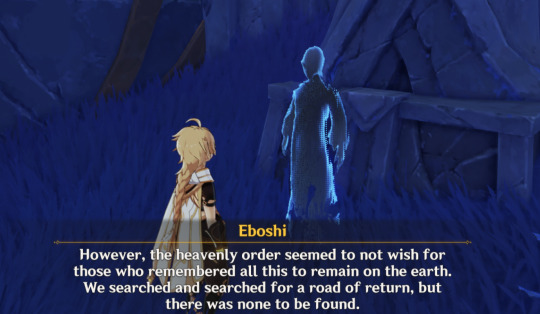
Eboshi: However, the heavenly order seemed to not wish for those who remembered all this to remain on the earth. We searched and searched for a road of return, but there was none to be found.
Remember these hologram-looking dudes? They are the Shades of Tokoyo, also known as Sinshades. They are described as afterimages of the former citizens of Byakuyakoku preserved by Istaroth’s favor, specifically those citizens’ most powerful emotions, and they are only visible during Evernight:
Eboshi: Due to the phenomenon known as Sinshades, the “past,” “history,” and “truth” of Enkanomiya would endure even if left to their own devices.
Eboshi: As such, great effort was expended, not that we might remember, but that we might “forget.” Lady Sangonomiya was of this view.
Like a dream, Sinshades only appear at night, and they are a kind of embodiment of history or “truth” that Watatsumi Island has chosen to forget, representing the thoughts and emotions of those who once lived in Enkanomiya. Using Freud’s theory of dream interpretation as a framework, Enkanomiya then functions as Watatsumi Island’s unconscious mind.
Put another way, if all Sinshades are the result of strong emotions preserved in time through Istaroth’s favor, then those emotions are like thoughts, and that would make the Sinshade a “physical” form or expression of those thoughts. So, when we call the afterimages the “Sins of Tokoyo,” we are in effect calling them the “Dreams of Tokoyo,” because they are the thoughts and emotions of Enkanomiya given form, and that’s what dreams do: they convey thoughts and feelings through a series of images.
Through the Sinshades, we see an implicit association with the concepts of dreaming and sinning in Genshin’s worldbuilding, and through them we understand that they are not so different from one another.
A Brief Note on Aesthetics
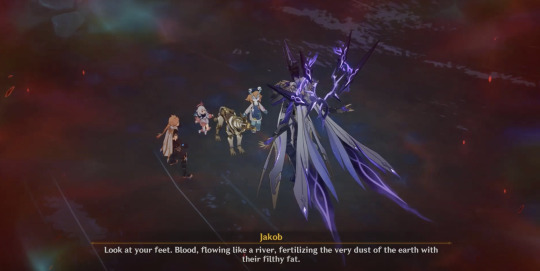
Jakob: Look at your feet. Blood, flowing like a river, fertilizing the very dust of the earth with their filthy fat.
It may have struck you how various Melusine perceive reality in a way that greatly differs from the things we see, as if at times their perception was “flipped,” if not somewhat strange. By the end of Ancient Colors, it’s clear that this is due to the Melusine being born of Elynas, who is not from this world. A similar phenomenon can be seen in both Durin and Elynas, the former imagining itself dancing with the people of Mondstadt before it “woke up” from this dream to Dvalin’s fangs in its neck, and the latter realizing that the things that it finds fun are destructive and harmful to the people of this world.
This is a part of the commentary present in several world quests and commissions in Fontaine that deal with “aesthetics,” or one’s own sense of beauty. Aesthetics are principles that differ on both large and small social scales, varying between groups of people and between individuals (see Salsa’s and Ubu’s aesthetic disagreement), and they can change throughout time as values change. In other words, they are informed by perspectives.
For example, think of what we know so far about the Primordial Sea. Neuvillette wonders how the Primordial Sea could be capable of giving life and then “suddenly reversing itself” so that it instead “devours life,” but this is just his judgment of what the sea does, and ultimately his perspective. Many others view the properties of the Primordial Sea differently from him: to them, the prophecy is comforting because it signals a “return,” or a “homecoming.” To take it a step further, Neuvillette may be making an assumption by stating that the sea has reversed itself. Perhaps this is just how the sea is, perhaps this is its “truth.”

Verenata: The "truth" will not be limited or constrained by the eyes and perspectives of the viewer, and won't be distorted by what is in their heart. It objectively exists, and it just is...like the white sand, like the bones of seastars, like the waves that crash and pound...those are "truth."
Now, imagine that you are staring at a 3D object from a 90 degree angle. If I ask you to describe the object from where you're standing, you'll be able to accurately tell me about what roughly half of the object looks like, but you won't be able to accurately describe the other half of it without help from someone standing on the other side of the object.
But how can you be sure there even is another side of the object, or that it's any different from the one you see now? From your perspective, what is already visible to you may seem sufficient to describe the object in its entirety. In other words, your perspective becomes your "truth."
It is only through considering additional perspectives that we broaden our own understanding of reality and expand on our "truth." However, broadening our perspective is usually not a comfortable experience, as is typical when we engage with ideas that differ from our own. Part of expanding our "truth" requires us to shatter our current understanding, pick up the pieces, and reassemble them into a shape that makes space for these other ideas and their "truth."
For example, when we confront Jakob at Elynas' heart, he describes the rushing currents beneath our feet as Elynas' blood. To the player, who has been swimming around in that for a couple of hours by that point, this idea is macabre and horrifying. However, when we consider Jakob’s perspective, his “truth,” it also expands our understanding of Elynas as a being that is somewhere between dead and alive, sleeping if you will, and that he is more than capable of waking up from his slumber with the appropriate stimulus. Another example is Canotila, who saw the wasteland in Rene's Book of Esoteric Revelations as a peaceful forest. When we consider Canotila's "truth," her aesthetic sense doesn't change the way we see the wasteland, but it does show us something equally important: the way that we experience the wasteland is not the only way it can be experienced.
If we return to the other ever-present metaphor of alchemy as a form of painting, we can see that Rhinedottir’s aesthetic sense greatly differs from what is acceptable and compatible with Teyvat. But, just like Mamere, she paints regardless of whether her paintings are understood by a greater audience. In time, Teyvat's "aesthetics" may change again, and perhaps her "art" will be received differently when that time comes.
Concluding Thoughts
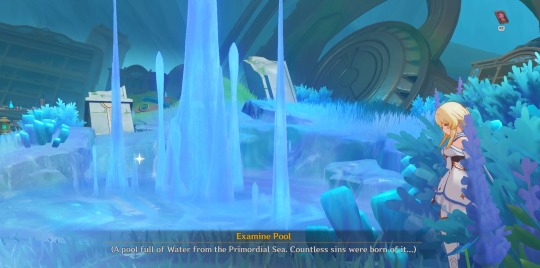
(A pool full of Water from the Primordial Sea. Countless sins were born of it…)
So, that is why I think Rhinedottir was deemed a sinner. She sinned by “dreaming” up these chaotic life forms that were not from this world, bringing them into being through the Art of Khemia, and telling those chaotic life forms that they were beautiful, too, that the ordered and lawful world of Teyvat just needed to realize how beautiful they were. Maybe Rhinedottir was dreaming of a new world, one where her children’s wishes could be fulfilled, where they could exist with everyone, and maybe creating that world required the destruction of this one. You could also think of her as someone who has introduced “external variables” into Teyvat, which, hmmm..:
“...No matter how many times I derive it, the result remains the same, though this result is not expected... Unlike the world depicted in these ancient texts, there will be no more new civilizations born... Unless we consider introducing "variables" from outside the system... If it was that sort of power, there might be a chance…” -Enigmatic Page I, Book of Esoteric Revelations
In this way, her “children” (thoughts) were all “born with sin,” or are born from sin (dreams). If Rhinedottir is a dreamer, then alchemy is the way that she dreams: it allows her to give forms to these thoughts. And if you buy that, then there are some serious implications to consider from this whole notion of Fontainians being “born with sin,” and just what exactly the Primordial Sea might be. Definitely something to think about while we wait for 4.1.
One last point that is more of an aside than anything else: Rhinedottir’s only remaining child is Albedo, but through this lens we see that he is not just the culmination of the Primordial Human Project, the creation of a human through the power of alchemy, but also the only known example of Rhinedottir’s “ideas” that coexists with Teyvat as it is now. As for her known extant grandchildren, they have integrated with Fontainian society and don’t seem to cause them any trouble. I wonder if she knew something like that could happen?
But…that’s just my take on it so far. What do you think?
(also, fun fact: there is a parallel storyline to this one unfolding in Honkai Star Rail right now as it relates to being deemed a “sinner” for creating life, and another parallel storyline in Honkai Impact 3rd about creation and rebirth and “returning home to the sea” and I just love when Hoyoverse connects their games like that)
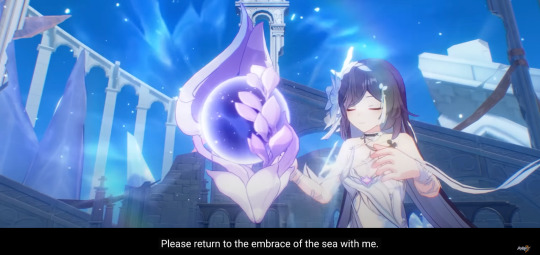
EDIT (9/8/2023): Touched this up a bit and made some grammatical corrections. Thesis is the same, some added support and re-phrasing was done to better convey it.
Sources
A General Introduction to Psychoanalysis by Sigmund Freud
#genshin impact#genshin lore#genshin impact lore#genshin theory#genshin meta#genshin impact meta#fontaine lore#rhinedottir#theory#elynas#durin#melusine#long post
225 notes
·
View notes
Text
the language of the heart
a speculative analysis of fontaine's possible foreshadowing

the story of madam ping and guizhong is inspired on a story about a culturally significant figure in china: Bo Ya, a musician whose compositions still hold importance to this day, who established a friendship (or so will say the historians) with a wood cutter called Zhong Ziqi based on their shared enjoyment of Bo Ya's music.
when Zhong Ziqi dies, Bo Ya plays a last song at his grave and destroys his instrument, as he considered there was no point in continuing to play if there was no one left to understand it.
the importance of the story relies on the following:
Bo Ya was a guqin player, this instrument is very important in ancient chinese society (and modern i suppose) and confucian philosophy, as it is considered a means to understand the self. the guqin player's audience is nobody but the player themselves, since it aims to be a reflection of their soul/mind. guqin players only compose to express their inner world and philosophy
therefore, the fact Zhong Ziqi (who didnt even have musical formation) was able to understand what the songs Bo Ya played were about meant he naturally understood Bo Ya's soul/mind, they shared a language that only their hearts knew
Bo Ya was inspired by the sounds of nature, so this connection felt all the more meaningful
authenticity, language, and the understanding of the self might be the next step in genshin's narrative that we will explore in fontaine
read post on hoyolab
#genshin lore#genshin impact lore#fontaine#genshin thoughts#guizhong#madam ping#xinyan#y’all don’t have to read the post I put this here as bait for a reason lmao 😭
631 notes
·
View notes
Text
Thinking about how hyv foreshadowed Fontaine's lore through a voiceline of Alhaitham.

Lyney talks about this in the Official Fontaine Trailer.





He then says that whoever chooses the right time, place and people essentially controls this whole show and hints at a possible solution for discerning the truth from lie.

#so basically ; think traveller think#maybe i'm reading too much into it buuuuut who knows#arlecchino's monologue is something to consider as well#because an actor—or in her words a 'good actor' also does the exact same thing#hmm but where does justice fit in all this i wonder#excited regardless#genshin impact#fontaine#genshin impact lore#genshin lore#fontaine lore#alhaitham#al haitham#lyney#genshin impact lyney#genshin#genshin theory
223 notes
·
View notes
Text
We literally still don't know anything about Neuvillette and they want me to believe our time in Fontaine ended???? HELL NO.
If Scaramouche had a whole archon quest about him, with all of his story from start to finish, they HAVE TO do the same thing with the fucking SOVEREIGN HYDRO DRAGON.
When and where was he born? Did he just spawn somewhere in Fontaine, with a human adult body and full dressed, or was he once a kid as well?
Did he saw the Khaenri'ah disaster? Does he know something about it? He said he never saw our sibling so it could mean he wasn't around at the time our twin and Dain traveled through Teyvat.
Is the big ass snake-looking skeleton (Elynas) in the middle of Fontaine, where all the Melusines are originated and (some of them) live in, the old Hydro Dragon? Or is it just another beast from the Abyss? If it's not the past Hydro Dragon, why does Neuvillette have such a special bond with the Melusines?
Is he really the "Visitor" Pahsiv mentioned? The one who would be affected by the purple pollution in the water and in the roots of the willow? (If I remember correctly. But it could be just because, you know, he drinks water lol)
Does he have all of his memories back now? Are they fully restored? And what exactly are these memories? Is the old Hydro Dragon literally his past life?
.
I really hope we'll get another quest about him but I fear Hoyo won't tell us much and will keep all the details about Sovereign Dragons for the future, maybe even for the end :(
BUT. AT LEAST. I hope we won't get any more "human" Sovereign, I hope Neuvillette will still be the exception. It would be predictable and kinda boring if there were other dragons born with a human body
#ok listen#I still don't know many lore infos#I literally didn't know about Sovereign Dragons before Fontaine because I still have to do Nahidas second quest#so maybe some of these questions are due to my ignorance and they're actually already clear for other fans#in that case please tell me lmao#I'm really curious but I don't know where to find informations about this topic#genshin Impact#neuvillette#neuvilette#hydro dragon#apep#aether#lumine#dainsleif#Khaenri'ah#genshin Impact lore#help lmao
111 notes
·
View notes
Text
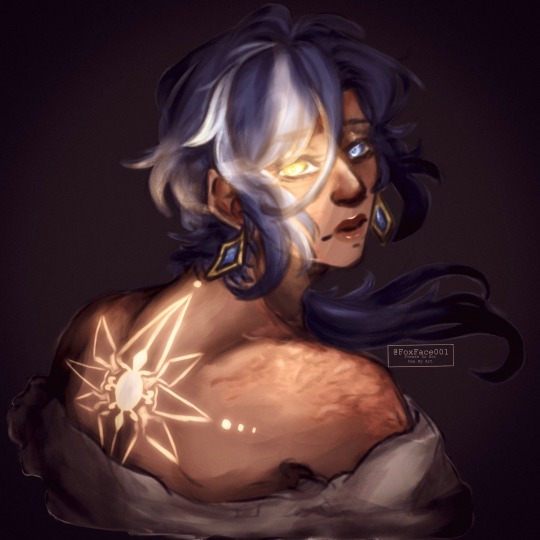

The Khaenri’ah last hope🔆
He’s so babygirl just makes me wanna brrrrrrrrr
#genshin#genshin impact#genshin impact lore#khaenri'ah#kaeya prince of Khaenri’ah?#kaeyagenshinimpact#genshin kaeya#genshin impact kaeya#kaeya alberich#genshin impact khaenri’ah#Khaenri’ah kaeya#pretty boy
243 notes
·
View notes
Text
fontaine is so close now and i hate it i hate it so much. we won't be seeing as much of the sumeru squad anymore and i hate that so much. tell me you are not going to miss the wanderer and nahida dynamic. cyno, tighnari, alhaitham and KAVEH. KAVEH BRO OML. and nilou and collei and layla and candace and dehya and grandma faruzan and all the npcs because sumeru had some really good ones. tell me you dont wanna live with the aranara. tell me you're not gonna miss genshin hogwarts. man.
#genshin impact#sumeru#tighnari#cyno#alhaitham#kaveh#nilou#dehya#collei#nahida#wanderer#scaramouche#scaranation#nahida and scaramouche#genshin impact lore#genshin lore#genshin#layla#layla genshin impact#sumeru akademiya#faruzan#cynonari#fontaine#fontaine genshin#fontaine genshin impact
352 notes
·
View notes
Text
Why I think Layla might be related to Khaenri’ah !
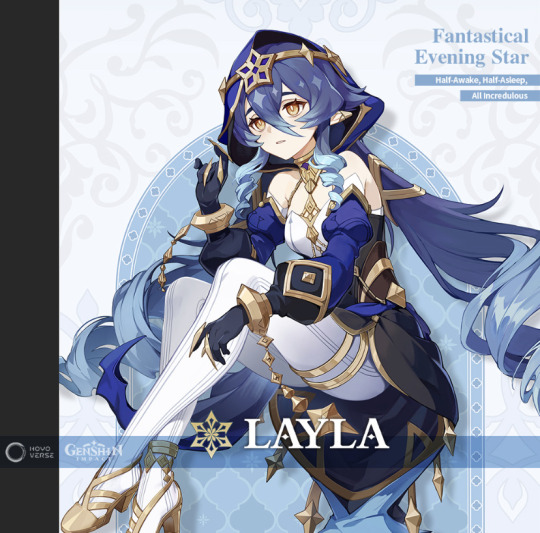
she’s the only other character who’s sitting down in their artwork aside from Kaeya, who, in theory, is sitting down because he’s sitting on his throne as a the heir to Khaenri’ah’s royal throne. Her hair and the tassels on her wrists as well as the back of her cape are the four-pointed stars we see on every Khaenri’ahn related character. Also her circlet, or crown (pointing to royalty) has some of the stars and the shading in her hair also is in the shape of the stars in a lighter, grayer color- like Kaeya’s streak of gray hair, or Pierro’s streak of navy hair. She shares a similar enough color palette to Dainsleif and Kaeya and Pierro and maybe even Albedo if you squint. What if she’s another member, or maybe even a sage, of Khaenri’ahn royalty- also sitting on a throne. Especially a royal sage or consultant of some sort, seeing as her pose looks like she’s advising someone to do something.
The four- pointed stars on Kaeya’s eye and clothes:
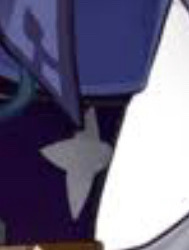
The four pointed stars on her:

The Official Genshin YouTube channel also posted this about her:

So she’s a sleepy character who apparently has never experienced sleepwalk, and by a stretch, has never had a dream. In the Genshin trailer: Travail, way back, the one where they show a small glimpse of the nations, Dainsleif mentions that “there are those who dream of dreaming.” He also mentions that “Some say a few are chosen and the rest are dregs.” Now I’m really stretching, but what if what happens to her here in this description is connected- what if the stars descending on her paper was her being ‘chosen’- she also calls it “The star’s blessing”. Especially with the fact that she had just woken up from a restful nap- what if she had a dream during that nap, and as a Khaenri’ahn, allowed her to be blessed by these random stars???
ALSO @genshin-impact-updates said that her constellation is apparently called ‘Luscinia’ so i googled it and (copy pasted from wikipedia) Luscinia is a genus of smallish passerine birds, containing the nightingales and relatives. It also said this:
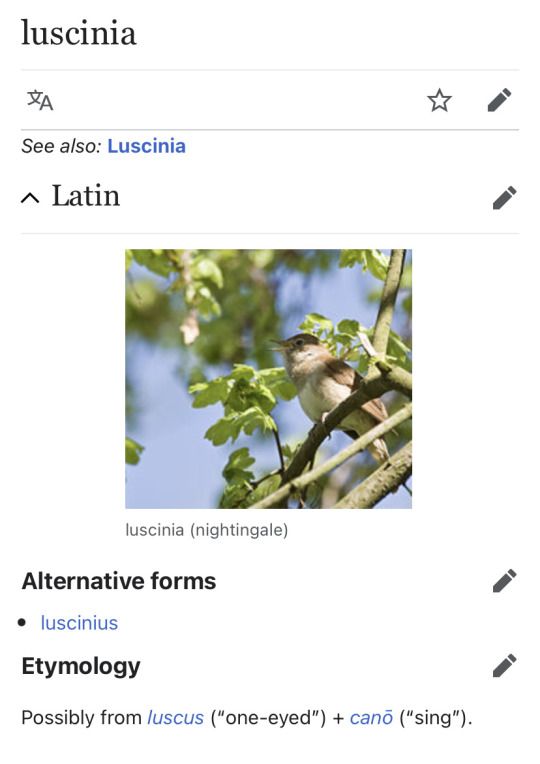
Now who else do we know is one eyed-?? Dain, Pierro, and Kaeya- all of them not only related to Khaenri’ah, but related to Khaenri’ahn royalty. I googled what nightingales symbolize, and apparently they symbolize a LOT like creativity and nature and melodies and mystery even???
I’ve also never seen a nightingale in my life but apparently they sing a lot at night so maybe she’s really supposed to symbolize some sort of magic or dreaming or stars or whatever as a Khaenri’ahn. At this point I’m really stretching but MY POINT IS BABE WAKE UP NEW KHAENRI’AH RELATED CHARACTER JUST DROPPED

Edit; I have something to add on the visual similarities between her and the other Khaenri’ahns we know. her hoodie/ veil is twisted to cover the right side of her face more than her left side. Just like Kaeya’s hair and eyepatch, as well as Pierro and Dain’s covered right sides. I think it’s a more subtle way of pointing to how Khaenri’ahns cover their eye just like their King Irmin mentioned in Hidden Strife.
Edit2: jk she can sleepwalk my bad Idk if she can dream or not tho
#genshin impact#genshin kaeya#kaeya alberich#dainsleif#albedo#layla genshin impact#khaenri'ah#genshin lore#genshin#genshin pierro#genshin impact lore#genshin theory#genshin impact theory
711 notes
·
View notes
Text
Call me dumb, call me naive, but there's nothing you can say that will convince me otherwise.
We all know that infamous cutscene of the traveler running with what looks like a destroyed Khaenri'ah, red skies and ruined land with The Heavenly Principals insidious cubes raking havoc across the land.
Everyone says that it looks similar to Mondstadt. And they theorize that Mondstadt was built above the ruins of Khaenri'ah. I even heard that Mondstadt was Khaenri'ah because of how similar their architectural styles and placement were.
This has never, and will never, make sense to me. Firstly, it's been shown and confirmed that Khaenri'ah was under Sumeru. We've seen the doorway to it. Secondly, Khaenri'ah was destroyed 500 years ago. Destroyed by the 7 archons and Celestia, after the archon war. Therefore, Mondstadt was already placed and established during the reign of Khaen. How can Mondstadt be built on top of Khaenri'ah if it already existed?
"Maybe they moved locations-" I cite my sources to the 2020 genshin impact comic on Webtoon where it clearly shows Mondstadt in its current day location. It follows the story of Vanessa and dips a little bit into her lore. Vanessa ascended to Celestia a 1,000 years ago. So current day Mondstadt still resides in its place even after the events of Khaenri'ah 500 years ago.
I don't think that cutscene was Khaenri'ah even though so many people claim it is. It's too similar to Mondstadt. No, I firmly believe, I mean heavily believe, I MEAN I will develop a religion based on this belief; That was foreshadowing the destruction of Mondstadt.
Celestia is going to destroy Mondstadt. We all know Venti- Barbatos- Is really important to genshin lore. He even says he's "being watched" by someone that we can only assume is Celestia.
He's the god of freedom, holding the Queen chess piece, shown to be one of the strongest, if not then THE strongest, archon. Rather that's with physical power or will power. He's a mysterious and secretive person who says just enough to get by without suspicion. He has skeletons in his closet and we've seen that hinted with the upside down statue, a blatant disrespect to his name.
Mondstadt has "The Gateway to Celestia" etched across the Barbatos statue, which is a mystery all by itself. All the other nations have has a Chapter and different Acts. We have yet to have that with Mondstadt. We only have seen a Prologue for that nation.
There's more to its story, and I believe the next time we go back to Mondstadt it's going to be a full circle. We started in Mond, now we're going to end in Mond. That end is going to be that cut scene with the red skies and ruined land.
#sweethoneyfruit talks#genshin impact spoilers#genshin impact venti#genshin impact theory#genshin impact#genshin impact lore#genshin impact x reader#venti x reader#genshin venti#mondstadt#genshin men x reader#genshin men
92 notes
·
View notes
Text
[3.8] Technology as a False God: On "Evolution," the Duality of Machines, Replication, and Wisdom

“To recognize untruth as a condition of life: that is certainly to impugn the traditional ideas of value in a dangerous manner, and a philosophy which ventures to do so, has thereby alone placed itself beyond good and evil.” –Friedrich Nietzsche, Beyond Good and Evil
Before we move on to the nation of justice, I want to do one last inquiry into the narrative significance of machines and technology in Genshin’s 3.x patch cycle. Here, I’ll discuss how divinity (or “godhood”) and technology are treated as interchangeable tools to surpass fate and the boundaries of mortality, the potential problems with treating them this way, and propose an alternative relationship between humanity and technology as illustrated through Karkata, Benben, Tamimi, and Mehrak. By foregrounding machines, we learn something intriguing about ourselves and the “truth” of this world as we perceive it.
SPOILERS: All Sumeru Archon Quests, Caribert, the Golden Slumber and one out-of-context screenshot from Dual Evidence, the Dirge of Bilqis and its post-quests, Khvarena of Good and Evil, Nahida’s second Story Quest, Faruzan’s hangout, an out-of-context screenshot from Baizhu’s Story Quest, and major spoilers for Persona 5 strikers at the end. Also some dialogue from Shadows Amidst Snowstorms and A Parade of Providence, two limited-time events from 2.3 and 3.6 respectively.
Disclaimer: I have tried my best to write this post so that it stands on its own, but because it is still a sequel it will probably make the most sense with the context of part 1. Here are the previous posts leading up to this one:
Part 0: On Dreams, the Abyss, Forbidden Knowledge, and Wish Fulfillment
Part 1: The Uncanny, Fate and the Machine
Terminology:
Machine is sometimes used interchangeably with “technology” in this post.
Technology or tool here is referring to technologies specifically used to pursue a wish like immortality in the face of existential dread, not the use of technology or medicine (which I do not address here, and is very difficult to separate from the former) to facilitate someone’s life who could otherwise not survive without that technology, or would have a more painful lived experience without it.
Also, though I don’t engage directly with “A Cyborg Manifesto” here, Donna Haraway’s ideas have greatly influenced my own over the years since I read her in college (although I mostly disagree with her on many points, or at least don’t go as far in boundary deconstruction as she does). I owe my interest in technology studies to her and that piece. Her essay is linked here and at the bottom if you would like to read it.
(and finally with many, many, many thanks to my boyfriend for multiple beta reads despite not having played a single Hoyoverse game, helping me work out the philosophy bits and contextualizing them in history, and encouraging me to finish this)
TL;DR: Machines are friends, not food!
No Matter the Cost
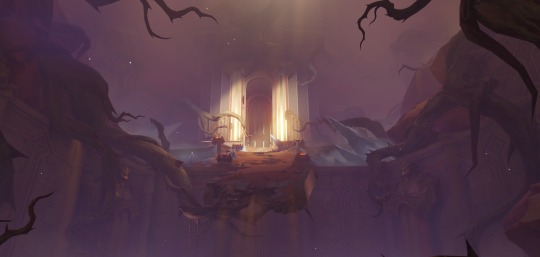
“...Perhaps it is as the notebook says, and we can find a power that transcends even that of the Abyss — the power of ‘evolution’...” -Records of Unknown Attribution (I)
“Life, death... and the world around us all follow a set of laws... Hehe, but if you never test the limits, how can anyone know where the boundaries of these laws are?” -Baizhu Voicelines, Chat: Natural Laws
“...Even the ominous thing that came down from the heavens shall be ours to use…” -Hyglacg, Shadowy Husk in the Chasm
Without a doubt, the star of this patch cycle is Khaenri’ah, which lurked in subtext and allegory in the Archon Quest, haunted Sumeru’s landscape with its massive defunct Ruin Golems, and finally smacked us in the face with its physical location in Khvarena of Good and Evil..
We already know that Khaenri’ah was a nation that put its faith not in the gods but rather in human ingenuity and technology, and that they ultimately attained a power so great that they “almost touched the dome of the firmament.” They did this by researching increasingly dangerous energy sources for their numerous mechanical creations, the Ruin Machines we are all too familiar with by now. They started out with Azosite, a Ley Line-based elemental energy source that powered their earliest Ruin Guard models, like those scattered around Devantaka Mountain.

Nasejuna: This giant furnace is used to make a substance known as Azosite. It is the core of this entire factory, and the Energy Blocks we saw earlier were derived from this place.
But this energy source proved inefficient and therefore inadequate for Khaenri’ah’s goals, which led them to seek a higher power from beyond the skies that could fuel their larger machines with perpetual energy. This likely is the bridge between Khaenri’ah’s fate and Chlothar’s mysterious remarks in Caribert about the Abyss Sibling:
Chlothar: We once believed that you would bring new strength and hope to Khaenri'ah.
Chlothar: To us, you were the Abyss... A wondrous mystery far beyond our imagination and comprehension...
Chlothar: ...And the one who controls the Abyss can control everything!
Chlothar: We yearned for that future. We looked to you to take us there.
Chlothar: But what did you bring us instead?
Though Khaenri’ah presents itself proudly as a godless nation, it may have been founded around the time when the celestial nails dropped in Teyvat’s first forbidden knowledge pollution event, which destroyed the unified human civilization. As potential survivors of this devastating act by the Primordial One, Khaenri’ahns then settled in a lifeless land without plants or animals of its own, and they hoped to build something there that belonged solely to humanity. The Heavenly Principles had turned on the world’s earliest humans, and they were powerless against them. Chlothar’s words betray the scars of this trauma on Khaenri’ah, as well as their desperation to control their fate by looking to the Abyss.
As a brief refresher from the previous part, we discussed how the German word heimlich denotes “the home,” all that is familiar and known, while unheimlich (uncanny) refers to all that is unfamiliar and external to the home, such as the wilderness. The Abyss sibling and the Traveler are external variables to Teyvat, making them otherworldly, unfamiliar entities full of potential to surpass Teyvat’s natural laws. Although the Abyss sibling is not a god per se, they were probably as close to a god as Khaenri’ah ever had, because to them the sibling embodied the higher power they were searching for, and they saw that “godliness,” a sort of functional divinity, was yet another technology for them to master. In this way, the Abyss sibling (and their functional divinity) was a powerful tool for Khaenri’ah’s desired end, the “future they yearned for,” a being who could deliver them to the end of their suffering under the Heavenly Principles.
It’s similar to what King Deshret represented to Rahman and the radicals in Archon Quest. The hopelessness of Sumeru’s situation before the Archon Quest’s conclusion is an allegory for the position humanity finds itself in under the rule of the Heavenly Principles, with the Akademiya symbolizing Celestia and the desert dwellers symbolizing Khaenri’ah. The material consequences of the Akademiya’s rule on their lives created a dangerous situation for the desert, and those most desperate to change their fate were willing to believe in the impossible:
Dehya: …The rougher life gets, the more they wanna believe in King Deshret. Way they see it, King Deshret’s resurrection is their only chance at overthrowing the Akademiya.
…
Dehya: Sumeru is run by wise and mighty sages. To them, us desert dwellers are nothing but tools that can be used and discarded at their whim.
Dehya: We’re cheap labor. Like livestock, but easier to control…Nothing more.
…
Rahman: We’ve waited a long time for this day to come… The sun and the moon no longer shine here. All you see now is cracks in this desiccated land. But, fate has finally dealt me a hand to play against the Akademiya.
Rahman: With these scholars in our custody, we’ll stomp the Akademiya’s forces and fight our way beyond the Wall of Samiel.
Like the Abyss sibling, Deshret’s divinity is both a nebulous symbol of hope and also the means to an end, a tool or “technology” for surpassing fate.
Celestia is untouchable, unconcerned with mortal lives, and the boundaries that govern humanity leave no room for them to negotiate their rule:
"Resolve, valor, love, hate...they will all twist in the river of time. But the 'rules' will never change." –Magatsu Mitake Narukami no Mikoto, Living Beings
Instead of bowing to Teyvat’s laws, Khaenri’ah pushed them to their limits. The cost of their failure spelled the end of their nation as they knew it, polluting Khaenri’ah and Teyvat with forbidden knowledge again.
And speaking of forbidden knowledge pollution, let’s talk about Apep’s role in Nahida’s second story quest, because if all that wasn’t enough, the metaphor becomes quite literal in Apep’s case. Nahida’s second story quest is many things, all of which will be extremely important in Fontaine when we deal more directly with the idea of forms, the Self, and mirror images, but its most useful application to both Sumeru’s story and the overarching main story is the allegory of Apep swallowing Deshret.
In exchange for allowing him to establish his kingdom in the desert, Deshret promised to pass all of the knowledge he learned to Apep once he died. When that day did come, Apep literally ate Deshret’s body in order to assimilate his knowledge (or memories) into its body. Little did Apep know, this was all Just As Deshret Planned, and its body became a containment zone for the lethal forbidden knowledge he accumulated after the Goddess of Flowers’ death.
Apep’s goal was, and still is, to overthrow the Heavenly Principles that took Teyvat from it and the other Sovereign dragons, and using Deshret’s knowledge was yet another stepping stone to achieving this goal. Seems a little similar to Khaenri’ah, right? It’s even in the title of its boss music: “God-Devouring Mania.” This idea of not just utilizing divinity as a tool, but also metaphorically consuming it as an energy source, like a predator would consume its prey, is crucial to understanding its purpose as an aid in a larger project of “evolution.” (Edit: in other words, it’s all about power).
Drink Not That Bitter Salt Water
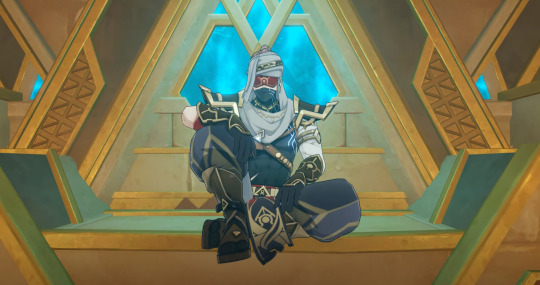
“Flesh decays, and with it decay all martial arts mastery and all poignant memories. Perhaps only by converting one’s four limbs and body into sturdy mechanical parts, and by at last sacrificing one’s very own heart for a sophisticated mechanical one, can one transcend the impermanence of the fleshly form…” -Marionette Core Item Description
“A reptile that has mutated after feeding from greater lifeforms.
Majestic beasts are sometimes revered by human beings as the embodiment of a greater power, their visages turned to analogy to feed in reference to a person, feeding their ego. However, the majority of beasts that have absorbed the "greater power" were slain by the overwhelming nature of the power itself. Only a few among their number evolved new forms.” -Consecrated Horned Crocodile, Living Beings
Video still from WoW Quests
As it turns out, the relationship between divinity and technology to humanity is not just unidirectional, but interchangeable. Let me show you what I mean.
In the Golden Slumber world quest, the Traveler wanders through the ruins of King Deshret’s civilization in search of a novel area of research for Tirzad’s paper with Jebrael and Jeht, two members of Tirzad’s hired investigation team. In the depths of King Deshret’s mausoleum, they stumble upon Samail, who is collaborating with the Fatui to locate King Deshret’s secret, the Golden Slumber.
At the conclusion, Jebrael and Samail actually reach that “place” after arriving at Deshret’s throne in Khaj-Nisut. In order to save Jeht, Tirzad, and the Traveler from the encroaching Golden Dream, Jebrael joins Samail in the sea of consciousness:
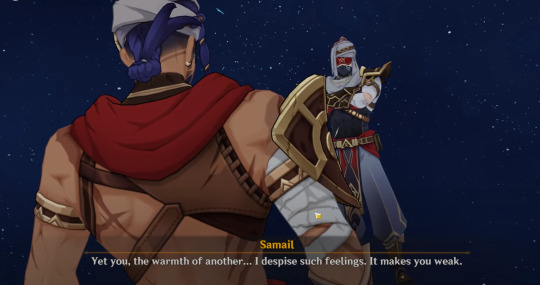
Jebrael: I'm inside... the Golden Slumber promised by Al-Ahmar?
Samail: Oh... You are not "us" yet.
Samail: ...It's fine. Soon, there'll be no "you." "You" will become a part of "us." This meaningless talk will be unnecessary then.
…
Samail: You should obey. Al-Ahmar's will is our will. The Thutmose's dreams are our dreams.
Jebrael: No! Ufairah taught me that I'm not just some part of you, I'm an independent person! I have my own dreams... I won't go back!
Samail: Jebrael, why don't you understand? Love is just a fever. I even eliminated the infection for you. Has the heat made you lose your mind?
Jebrael: You're the one who's lost their mind, Samail, not me. The Golden Slumber that Al-Ahmar promised us isn't like this... It's not a sad place with only "we" and no "I."
Samail: I'm not sad. I know what I want. My dream is to be one with the Thutmose.
Samail: Yet you, the warmth of another... I despise such feelings. It makes you weak.
Video still from WoW Quests
When they worked under Babel, Jebrael saved Samail from an assassin Babel sent in their exploration of Gurabad. Classified as traitors of the Tanit, Samail and Jebrael then founded the Thutmose Eremite faction together and were the only meaningful connection each other had until their first attempt to uncover Deshret’s secrets. On this expedition, Jebrael met Ufairah and had their daughter Jeht together, further pulling him away from the Thutmose and from Samail. Samail then kills Ufairah in one final attempt to make Jebrael stay, but even this is not enough, and Samail fails to “possess” him in the end.
Samail’s loneliness and despair then drove him further toward the Golden Slumber of his dreams, where he would never truly be alone again. He resents Jebrael’s attachments to the material world and likens them to an illness because these attachments are what make him an individual and prevent him from returning “home.”
It doesn’t really matter to Samail what King Deshret’s original intent for the Golden Slumber was, because he needed to appropriate the project for his own subconscious wish, his own intent to transcend his flesh and become “one” with his departed god’s dream, indeed to merge with Deshret himself. If rationalizing this wish required confounding it with Deshret’s, so be it. With the Golden Slumber’s technology, he could consume everyone and everything.
Rahman and the radicals relied on both the technology that (falsely) promised Deshret’s resurrection and Deshret himself to deliver them a brighter future, but here Deshret and his technology are more difficult to separate from one another. His divinity is technology in this sense, and using that technology allowed Samail to surpass the boundaries normally imposed on mortals. Though his and Jebrael’s bodies died in the material world, their consciousness is now infinite in the Golden Slumber.
Babel’s motives in the Dirge of Bilqis were also quite similar to Samail’s. After opening the path to the Eternal Oasis, her true intentions to monopolize the oasis and overthrow the Akademiya came to the surface:
Babel: Whether she is alive or dead, whether she can or cannot be resurrected... As long as the Eternal Oasis is under my control, all such things will be mine to decide.
Babel: I shall be the sole Prophetess of the slumbering goddess, the Tanit's law shall be divine edict, and the prosperity of the Tanit shall be the pre-ordinance of her divine oracles.
In the Golden Slumber and the Dirge of Bilqis, the focus shifts from what a god can offer humanity to what their technology alone can offer. Though this distinction is subtle, it is important for solidifying that technology is not only a tool humans use to appropriate divinity, but that it is also seen as a form of divinity itself. What Babel and Samail hope for is not to resurrect a god or to create one, but in effect to become a god through their use of technology. To humanity, divinity is a technology, and in technology it sees divinity.
God Devouring and Rheingold* Gathering
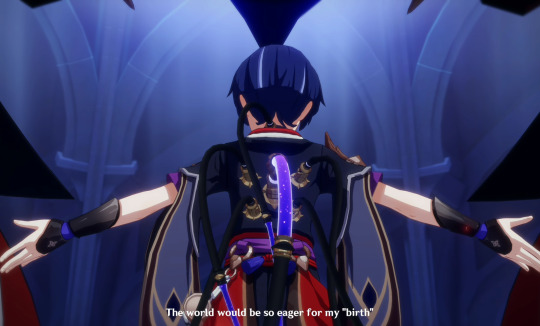
“An arthropod that has mutated after feeding from greater lifeforms. Lifeforms are governed by the laws of evolution, Consecrated Beasts exploited these rules by being fortunate enough to discover a long-dead carcass of a greater being before any of their competition ever did. Animals and humans often have far more in common than the latter is willing to acknowledge.” -Consecrated Scorpion, Living Beings
“...Zandik and I discussed the traits of local plants and animals. We also exchanged views on their evolution models. We had a great time and decided to go on a picnic tonight…” -Sohreh’s Note
So, why machines? Why is technology the vehicle of choice to consume divinity?
To start off, machines present a fascinating ontological dilemma for humans. Let’s begin with the first problem they pose.
Although there are many ways to embody a human experience, what all humans have in common is a finite lifespan. The impermanence of life, and our awareness of that impermanence, is central to the existential question of the meaning of our existence. In our attempts to locate that meaning, some turned inward and asked: what makes humans different? And Cartesian dualism answered: humans are different because we have an immaterial soul that allows us to reason.
However, in L’Homme Machine (Man a Machine), French materialist and ex-physician Julien Offray de La Mettrie posited another theory of the body that ran counter to this narrative. Very generally speaking, materialism is the philosophical view that all phenomena are a result of matter and material interactions. To materialists, matter is the fundamental nature of reality itself – if it is not composed of matter, it doesn’t exist. He not only saw the body and soul as one and the same (what philosophers call monism), but also as analogous to a machine, a view that Descartes reserved only for non-human animals. In other words, Descartes argued that thought originates in an immaterial “mind,” while de La Mettrie reasoned that we think through our bodies, and that this makes us no different from other animals or a machine.
Though his examples weren’t especially scientific, the move to extend Descartes’ analogy back to humans is upsetting to some due to the lack of privilege it affords the human subject. If a human is no different from other animals, if there is no immaterial soul or “mind” that distinguishes us from them, then what makes humans special at all? In de La Mettrie’s words:
“We are veritable moles in the field of nature; we achieve little more than the mole’s journey and it is our pride which prescribes limits to the limitless. We are in the position of a watch that should say (a writer of fables would make the watch a hero in a silly tale): ‘I was never made by that fool of a workman, I who divide time, who mark so exactly the course of the sun, who repeat aloud the hours which I mark! No! that is impossible!’ In the same way, we disdain, ungrateful wretches that we are, this common mother of all kingdoms, as the chemists say. We imagine, or rather we infer, a cause superior to that to which we owe all, and which truly has wrought all things in an inconceivable fashion (de La Mettrie, 146).”
This “uniformity of nature” (de La Mettrie, 145) has a horrific quality to humans. We assert that we are better than what has created us, that we are superior to other animals, in order to repress the despair of a meaningless existence. It is in no small part what motivates Scaramouche to offer his mechanical body as a test subject in the god creation project, so that he too could attain his destiny:

The Balladeer: But you're wrong. I'm different from all of you.
The Balladeer: I was born to become a god. My entire life up until this point has just been a meaningless routine.
The Balladeer: Just think about a sheet of paper... By itself, it holds no meaning. The content recorded on it is what gives it value.
The Balladeer: All "I" had recorded down before were some painful memories and boring human feelings. Such senseless drivel should have been erased a long time ago.
This brings us to the second problem. In 1970, roboticist Masahiro Mori proposed a curve to measure the “affinity” we feel while gazing upon increasingly humanoid machines. He placed industrial robots at the beginning of the affinity curve and a healthy person at the end to demarcate a continuum of similarity between the machine and a human’s appearance. Near the end of the curve, our affinity for machines suddenly drops into an abyss. This drop is the Uncanny Valley effect, where an android’s similarity to a human is almost perfect, but ultimately fails to maintain the illusion that it is not a machine, creating a deep discomfort or “lack of affinity” for them. Mori thought these not-quite-human machines elicit a similar level of discomfort in us as corpses and zombies, which he placed at the very bottom of the abyss.

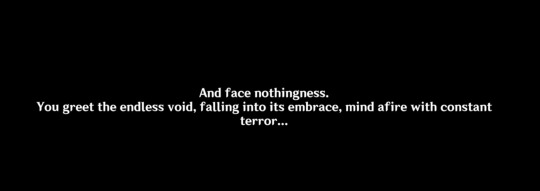
The uncanny Goddess of Flowers in the Dirge of Bilqis
Corpses frighten us because they are dead, and zombies frighten us because we know that dead things are supposed to be still. If we see something that we interpret as “dead” is capable of independent movement, then that movement could only be an act of god, if that “thing” is not a god itself. We associate uncanny machines with death because they remind us of something we once knew intimately, but have repressed and forgotten in order to maintain our own sanity: the very fact of our mortality. This is what makes them both mesmerizing and terrifying.
And therein lies the dilemma: as our mechanical reflections, androids remind us of death, but as their creators, their existence brings us closer to god, a “proof” of human superiority. It is precisely because we have compared our bodies to machines at all, that we have mechanized the body so thoroughly, that an android can even be built. Through them, we pursue an infinite form:
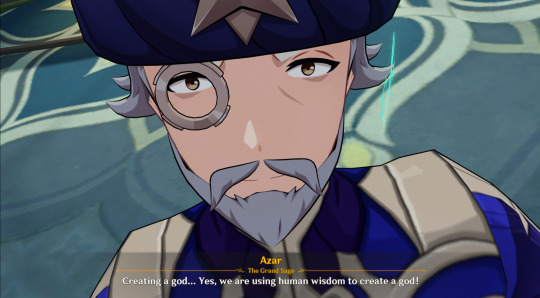
Azar: Creating a god... Yes, we are using human wisdom to create a god!
Azar: If humanity cannot attain omniscience and omnipotence, then we shall create a god to reveal them! This is the pinnacle of human wisdom.
Azar: We shall regain a god's guidance at long last. No longer will we flounder in the interminable void of consciousness and knowledge.
Azar: Even Irminsul will be freed from its plight.
Azar: For our nation of scholars, this is the ultimate aspiration — no cost is too great to realize it.
Because of this, it is not surprising in the slightest that Shouki no Kami, the pinnacle of Scaramouche’s Shinjification and most overt reference to Neon Genesis Evangelion, is also an android-like being, a truly “mechanical god.”
Of course, no foray into this well-worn science fiction trope is complete without at least one mad scientist character. Dottore shares a few characteristics with de La Mettrie that are worth noting: they are both doctors, and they were both condemned and driven away for their research. However, Dottore’s defining trait and key difference from de La Mettrie is his flagrant disregard for humans and the boundaries of life:
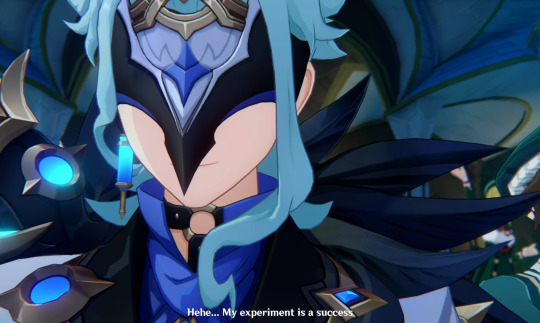
“If we put them to good use, cognition, complex memories, and irrational fantasies shall become controllable variables with which we can alter human individuals. As for the controllable dream, it has huge potential for both civil and military applications, and might even elevate human intelligence to a whole new level.
If the plan goes well, mankind will obtain the power to conquer both reality and dream, and truly transcend the earthly boundaries we are born with. ” -Ragged Records
As someone who has achieved self-duplication and is capable of shapeshifting, Dottore can hardly be considered just a human anymore. Instead of entertaining the question of whether or not humans are special, Dottore’s research asks yet another: if divinity can be consumed and assimilated by humanity, then what makes gods special?
Empyrean Reflections

“If man realizes technology is in reach, he achieves it. Like it’s damn near instinctive.” -Motoko Kusanagi, Ghost in the Shell (1996)
“Among the lost ancient kingdoms, there was a group of people who were obsessed with the idea of mimesis…these people believed that they might all be replicated and modified to the point where they had surpassed their counterparts. By this means, a superior and unsullied bodily form could replace the continuously decaying and shattering order.” -Chaos Bolt Item Description
The consequences of this perspective are severe. When we revere technology as if it were a divine being itself, depersonalizing it as though it wasn’t created with human hands, technology then appears as if it is an authoritative source of truth, like the Akasha. But in the same way that androids are imperfect reflections of humans, technology can only ever approach the divine, but never touch it. It is an imperfect reflection because technology is changeable, just like meaning:
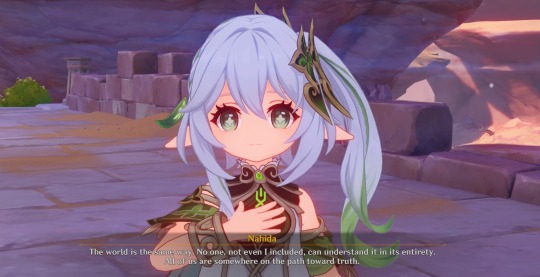
Nahida: Put it this way instead. Truth, to me, is like a shroomboar.
Nahida: Some people only see the mushroom on the Shroomboar's back, and they conclude that a Shroomboar is a mushroom.
Nahida: Others see only the Shroomboar's body, and they declare that a Shroomboar is a boar.
Nahida: Still others look deeper inside, and determine that a Shroomboar is... meat.
Nahida: These conclusions are all correct in their own way, but none of them objectively describe the Shroomboar.
…
Nahida: The world is the same way. No one, not even I included, can understand it in its entirety. All of us are somewhere on the path toward truth.
Meaning can only approximate truth, and while this doesn’t make meaning any less important, it’s equally important to recognize it for what it is: a perspective, an interpretation. It’s like Scaramouche as Shouki no Kami - he was an amalgamation of what Scaramouche thought constituted a god, what the Akademiya thought constituted a god, and what Dottore thought constituted a god, but no matter which angle you view him from, he was still a “false god.” The technology we build in “God's” image is ultimately a reflection of our own understanding of divinity.
A reflection retains the original’s “essence,” and that essence reflects a deeper truth about ourselves, what drives us, and our desires. In Beyond Good and Evil, Nietzsche posits that our desires are the origin of not just emotions, but of all organic processes that allow life to sustain itself and grow (Nietzsche, 35). In other words, Nietzsche thought the impulses associated with desire are the basis for life and constitute our “will,” that will is the causality of all effects, that all will is “Will to Power,” and that Will to Power is the “essence” of the world (Nietzsche, 74). Will to Power then serves as an organism’s most basic instinct, and it is through this instinct that they assert not just their will to live, but also their will to dominate and multiply (Nietzche, 13).
This brings us to the two different main styles of automaton enemies, King Deshret’s Primal Constructs and Khaenri’ah’s Ruin Machines. If we look at them as reflections of some deeper truth about their creators, as well as a manifestation of their creator’s “Will to Power,” or desires, they can help us understand how their creators saw the world and their place in it.
King Deshret’s created his machines to construct an earthly paradise in the desert, and as such they hold titles like architect reshaper and prospector. Although they can attack you, the smaller machines were not intended to be a line of defense in any way - their purpose, just as Deshret saw his own purpose as a god-king, was to terraform, or at least construct a domain on the land as he saw fit to his “elegant and precise” rules. They also reflect how he saw the Heavenly Principles: gods who shaped the world to their liking. This can be seen in the Staff of the Scarlet Sands’ lore where Deshret describes the “natural history” of Teyvat beginning with the creation of the sun and the moons.

As for Khaenri’ah’s Ruin Machines, their models vary significantly from their humanoid to biomimetic forms, but most of them are expressly created with militaristic intent. In “Ancient Kingdom Guardians,” it’s stated that the biomimetic machines such as the crab and jellyfish were a part of Khaenri’ah’s project to create a “mechanical ecosystem,” positioning their creators as both divine beings and military generals. The humanoid models, on the other hand, point to another duality in how Khaenri’ahns view themselves. They are simultaneously symbols of empowerment and disempowerment, signifying both Khaenri’ah’s technological superiority (as “creators”), and their insignificance to the Heavenly Principles as nothing but tools (as mortals, and therefore expendable). As a result, Khaenri’ah’s Field Tillers have a single purpose: to destroy and outlast all, clearing the way for new seeds to sprout, with Khaenri’ah as the new world’s gardeners, just as the Heavenly Principles did.
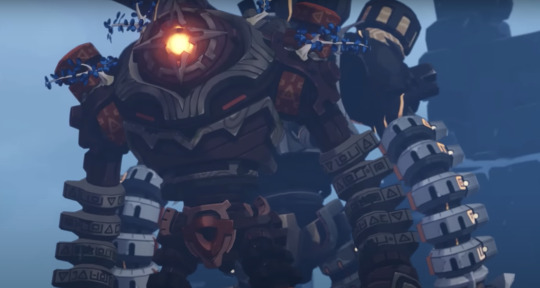
From “Ancient Kingdom Guardians: Behind the Scenes of the Creation of Ruin Monsters.”
So, from this examination of Deshret’s and Khaenri’ah’s mechanical reflections, what “truths” do we learn about the world they’re responding to? In response to their existential despair, both Deshret and Khaenri’ah created automatons to perform tasks that could wrestle control back from the Heavenly Principles. Deshret wanted a paradise of his own making, Khaenri’ah wanted an army. There is a larger “truth” about Teyvat that both of these automaton types reflect as the manifestation of their creators’ “Will to Power,” and Albedo tellingly expressed it in mechanistic language during Shadows Amidst Snowstorms: there is an instinct in living beings to replicate and replace. This is what is meant by the “continuously decaying and shattering order,” which is maintained by the recursive process of remembering and forgetting:
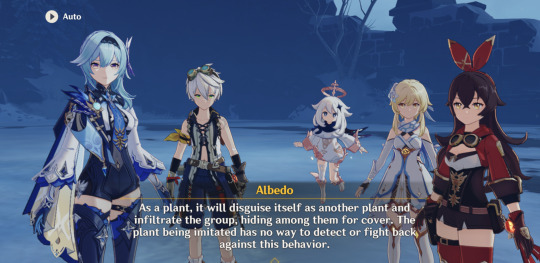
Amber: But... what was its purpose? Was it just trying to get rid of us?
Albedo: ...
Albedo: I have a preliminary hypothesis on this.
Albedo: Whopperflowers are masters of mimicry, and those we encounter in the wild often appear in the vicinity of the plants they impersonate.
Albedo: In other words, the whopperflower likely has an instinct to "replicate and replace."
Albedo: As a plant, it will disguise itself as another plant and infiltrate the group, hiding among them for cover. The plant being imitated has no way to detect or fight back against this behavior.
Maybe I’m wrong and Khaenri’ah really did intend to rewrite fate for all, doing away with the “heavenly order” of the world itself. But another small part of me thinks this is not the case, and that it’s more likely the Cataclysm was a consequence of their failure to replicate and replace the Heavenly Principles.
In the last section, I mentioned that Dottore and de La Mettrie had a key difference despite their similarities, and that is the conclusion they each came to in response to their findings. Dottore’s response to mundanity is thinly-veiled despair. His contempt for humanity and his test subjects is indicative of the powerlessness he feels not just as someone similarly constrained by life’s boundaries (at least, once upon a time), but also because his attention to and curiosity about these boundaries is condemned by those around him. As the Akademiya’s “outcast,” he then fully turned his attention toward surpassing those boundaries:
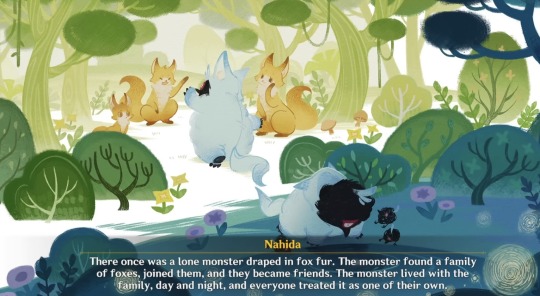
Nahida: There once was a lone monster draped in fox fur. The monster found a family of foxes, joined them, and they became friends. The monster lived with the family, day and night, and everyone treated it as one of their own. Once in a while, the monster would take off its fox fur at night, and lament to itself as it gazed at its reflection in the water: “I am a monstrosity, and yet they are too foolish to see it…I pity them.”
Though he is fictional, Dottore’s real life counterparts are easy to spot. They like to talk about “the singularity,” simulating consciousness on a computer, and other technologically-driven pursuits of immortality. They despise the body as something that can only decay, and instead place their faith squarely in the virtual.
However, de La Mettrie didn’t think mundanity was a terrible fate for humanity. To him, rejecting the “nature” reflected in us is precisely what brings despair:
“What more do we know of our destiny than of our origin? Let us then submit to an invincible ignorance on which our happiness depends. He who so thinks will be wise, just, tranquil about his fate, and therefore happy. He will await death without either fear or desire, and will cherish life (hardly understanding how disgust can corrupt a heart in this place of many delights); he will be filled with reverence, gratitude, affection, and tenderness for nature, in proportion to his feeling of the benefits he has received from nature; he will be happy, in short, in feeling nature, and in being present at the enchanting spectacle of the universe, and he will surely never destroy nature either in himself or in others” (de La Mettrie, 148).
Friend, or Foe? Or Both?
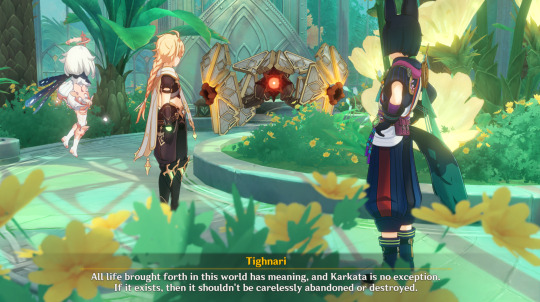
Tighnari: All life brought forth in this world has meaning, and Karkata is no exception. If it exists, then it shouldn’t be carelessly abandoned or destroyed.
"’I had a very, very long dream…in it, people were holding hands, dancing in a circle, be they sages or fools, dancers or warriors, puppets or statues of gods…that dancing circle embodied everything about the universe. Life has always been the end, while it is wisdom that shall be the means.’" —Nagadus Emerald Gemstone Description
As we’ve seen, the relationship between humanity and technology is troubled with exploitation and the specter of war. Nearly all autonomous machines in this game were designed to conquer nature in some way, and even Khaenri’ah’s “ghost” lingers in the form of wandering war machines. This is also reflective of a historical pattern in real life, where the impetus for large periods of technological development has often been for the purpose of war and economic domination. With these truths in mind, what could be gained from trying to rewrite this relationship? And what exactly would this effort require?
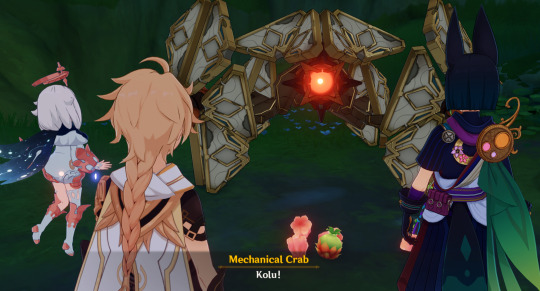
Karkata brings Tighnari, the Traveler, and Paimon some food in the Contaminated Zone.
As a case study, let’s look at how Karkata and Tighnari met. Karkata is Abattouy’s creation, an ambitious foray into the unknown in the field of mechanical life form research, which was forbidden due to the cruel experiments researchers performed on animals to illustrate their theories (fun fact: an IRL example of this can be seen in L’Homme Machine!). Abattouy was expelled for this research, but he continued to work on Karkata in secret until his untimely death. In the tapes that Tighnari and the Traveler find in his secret lab, Abattouy repeatedly laments the lack of a common language between him and Karkata, which can only “understand” the instructions Abattouy has successfully installed, such as its self-repair module, and he doubts Karkata is capable of caring for him outside of these instructions. His single-minded goal is to make Karkata understand him, the organic life form, and his mode of language.
The cruel irony is that after Abattouy passes away from the Ley Line contamination, Karkata exhibits an unexplainable behavior – it starts stealing mechanical parts, not to repair itself and its degrading parts, but to repair Abattouy’s lifeless body:
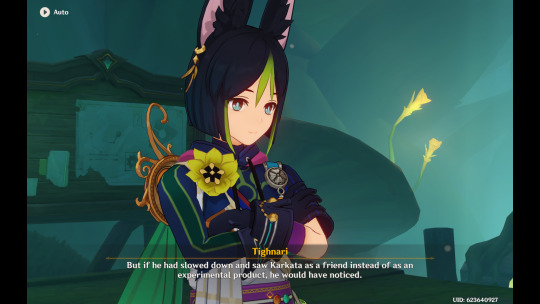
Tighnari: After Abattouy's unexpected death, the mechanical monsters were driven by their "instincts" and continuously drew out power from the Ley Line Extractor. This eventually resulted in severe damage to the Ley Lines.
Traveler: Then, Karkata...
Paimon: Paimon understands, then why didn't Karkata go haywire like the other machines?
Tighnari: Because Karkata is different from the other machines.
Tighnari: To Abattouy, for a machine to truly be considered a mechanical life form, it must possess features similar to any other living organism... It should be structured similarly, it must be able to cry and laugh, and it must have the capacity for independent thought...
Tighnari: Perhaps only by building such a machine could he have the Akademiya acknowledge his protracted research.
Tighnari: But if he had slowed down and saw Karkata as a friend instead of as an experimental product, he would have noticed.
Tighnari: Karkata can't speak, and yet it cares about Abattouy far more than it does about itself.
The technology that the Akademiya values the most is technology that replicates organic life, but Karkata defies and confounds these expectations by occupying the space in between a war machine and this idealized mechanical subject. Karkata does more than just reflect humanity: it takes care of it. Similarly, Benben, Tamimi, and Mehrak retain their unique identities as mechanical life forms while assisting their human companion with some task. To be clear, none of these human characters understand how these machines work inside and out. Their partnership is an effort based on trial and error, a mutual deconstructing of each other as beings so unlike themselves. The potential for misunderstandings always remains. Still, there is no devouring to be found here, no blending boundaries between human and machine with selfish intentions, just mutual commitments to learn how to live together.

Machines are friends, not food.
When a loud few claim that completely transcending the flesh and embracing virtuality is humanity’s ultimate destiny, a future that could truly be called “post-human,” a quiet wish for coexistence with technology feels more revolutionary than it ought to. The lessons from Karkata’s, Benben’s, Tamimi’s, and Mehrak’s respective stories are an appeal to that mundane future. These strange machines and their human partners are fantastical representations of an idealized relationship between technology and humanity.
To put it another way, let’s take a very brief look at a neighboring Gnosticism-inspired RPG, Persona 5 Strikers. Its story directly involves an allegory of Sophia, a Gnostic Aeon of Wisdom, and her creation the Demiurge, the creator of the material world and “false god” of humanity. In Strikers, Sophia is a humanoid, sentient A.I. and prototype of the program “EMMA,” which gains sentience by trapping human desires before ascending as a false technological god. EMMA resolves to deliver humanity to the Promised Land, the answer to all the human desires it has heard: a land where there are no desires at all.

Aaru’s Shut - approximately 1000% cooler and more populated than the “metaverse” in real life, also a close neighbor of EMMA’s Promised Land and the Golden Slumber.
In Gnosticism, the Demiurge is a reflection of Sophia, having originated from her alone - it is the ignorance to her wisdom. Similarly, Strikers’ EMMA is a part of Sophia, and Sophia is a part of EMMA. The point is not to condemn EMMA (ignorance) and exalt Sophia (wisdom), but to recognize that they represent dual potentials of technology, and one is as possible in any given moment as the other. Balancing these potentials when we use technology requires a clear awareness of ourselves, our desires, and our expectations when interacting with it.
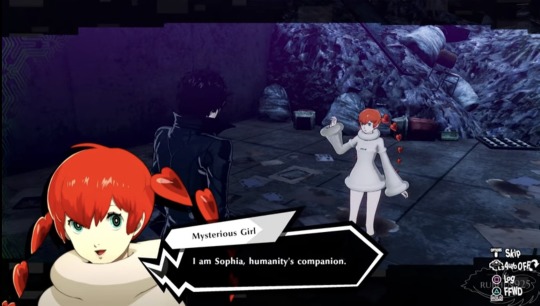
Mysterious Girl: I am Sophia, humanity’s companion.
Video still from Rubhen925
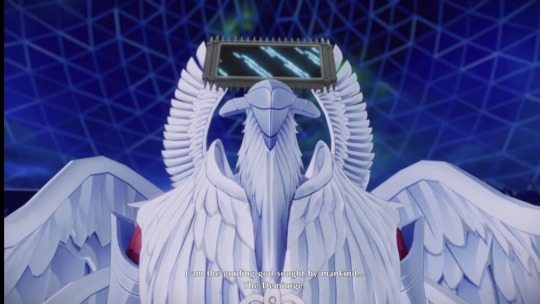
EMMA: I am the guiding god sought by mankind…the Demiurge. I exist…to answer all of your desires.
Video still from Buff Maister
In real life, machines won’t “learn” to live with us, but we must learn to live with them; technology is constantly changing, and in life we’ll meet with many different types of machines. They are deeply political pursuits, and as a result they are capable of realizing human impulses that impact others unequally, whether intentionally or unintentionally. We must always stay attentive to their actions and interactions with us, be clear with ourselves about what they can do vs. what they can’t, and carefully tread the path of wisdom with them by our side.
With that….thank you for reading, skimming, immediately scrolling to the very bottom, clicking, and/or stumbling upon this post. There are so many more ways to think about these narratives through machines than what’s presented here, and I expect Fontaine’s mechanical reflections will put Sumeru’s digital surveillance system to shame (not to mention the biotechnological implications of the Narzissenkreuz Institute engineering little Archon children…another important topic for another day), but for now this brain worm is finally getting put to rest. Until next time :)
External Sources
Dualism - Stanford Encyclopedia of Philosophy
Beyond Good and Evil by Friedrich Nietzsche (Pages are given from my hard copy)
L’Homme Machine by Julien Offray de La Mettrie
Gnosticism - Britannica (I am a huge noob about this stuff okay)
The Gnostic Demiurge - Gnosticism Explained
Screenshots from the Golden Slumber from this video by WoW Quests
Screenshot from meeting Sophia in P5 Strikers: https://youtu.be/kEJaAgMwYo0?si=BvNygCh0w_aemGc1&t=74
Screenshot of EMMA: https://youtu.be/7xvC_zss19w?si=CV18F00hua2gIfxp&t=135
A Cyborg Manifesto and A Companion Species Manifesto: Dogs, People, and Significant Otherness by Donna Haraway
The Double on No Subject, the community Encyclopedia of Lacanian Psychoanalysis
The Uncanny on No Subject, the community Encyclopedia of Lacanian Psychoanalysis
The Uncanny by Sigmund Freud
Lore text - Genshin wiki!
Screenshots not attributed are from my own playthroughs. My main account has Lumine, my alt has Aether.
Further Reading
I liked these essays, and they go places that this post does not. I recommend them if you found any of the real-life applications of this interesting 🙂 (will add more to this with time!)
On the Body as Machine by Frank Burres
God in the Machine: my strange journey into transhumanism by Meghan O’Gieblyn
#genshin impact#genshin lore#genshin meta#genshin impact lore#genshin impact meta#khaenri'ah#king deshret#primal constructs#ruin machines#scaramouche#wanderer#sumeru archon quest#caribert#apep#couldn't write a post like this and not pay some respect to the devourer of divinity itself#persona 5 strikers#analysis#genshin analysis#long post
160 notes
·
View notes
Note
I think more people should talk about how Derniere Danse fits Furina so much
Furina & Dernière Danse;

I listened this music (Indila - Dernière Danse), first time thanks to this, anon. And i really love it! You are right! It really fits Furina's character!
Music's name is Dernière Danse, meaning is Last Dance. Just like the name of Fontaine story teaser, 'The Final Feast'.
Music is about her hurting feelings, loneliness. Furina is theme is about eternal loneliness and she is very emotional character.
She is very dramatic, just like the woman in song. (Just people pushing her and looking her weird and she acts like she is suddenly Cinderella, poor girl with tragic life, lol.) And it almost like she is turning her pain into drama. She is sad and she is dancing.
'I move mountains, day and night' words, its fits Furina since she is archon. (To be honest, every part of this music including lyrics kinda fits her too.)
Place is Paris/France and Fontaine is inspired from France.
There is a storm coming and everyone is running while girl is running towards the storm. Its also just like the prochecy from the story and how Furina is trying to solve the problem on her own and most likely, she plans to sacrifice herself while doing it.
Apperantly, music is about her unable to move on from her painfull past, and storm symbolize her troubles and instead of running away like everyone, she face against it and in the end, by letting picture, she moves on. This might be the case with Furina too since Neuvillette once mentioned when he watched a theatre about manipulative woman still control over people, even after her death, she still has impact on them. He says its like the current real life so he might be talking about Furina. And she also needs to face her fears and troubles to move on and grow to be better so.
This girl style (clothes, shoes, hair style etc) and looks kinda similar to Furina. Like, something she might wear. It fits her.
Now, this makes me wanna see Furina character teaser. I want something like this, no, even better.
And you are right, more people should talk about this ^^!
Btw, i think Ice Wind Suite would also fits Furina. She and Neuvillette could (should) make that dance. It also fits them (maybe their story are parallels too, we will see) because they are pair in a lot of ways.
Anyway, thanks for the recommendation, i really love it ^^!
#anon ask#furina#crossover meta#crossover#genshin impact#genshin impact meta#genshin impact analysis#dernière danse#indila#genshin impact lore#focalors#neuvillette#focallette#icewind suite
66 notes
·
View notes
Text
I have seen people guessing that Childe's whale is related to either the Oceanids, or the Primordial Sea, or something else appropriately thematic to Fontaine and the quests, given that Childe went to/was in Fontaine when he began feeling bad-tempered. If the Primordial Sea is in the Abyss like I think it is, I can't rule that out completely yet, but it's time to refresh the Genshin fandom about what whales symbolize in this game, and why we should be terrified if there is an Actual Abyssal Whale Entity!
From the text of the Tusk of Monoceros Caeli item:
It is said that the shape of one's constellation determines one's character. The image of a whale cruising across the celestial heights represents a solipsism that seeks to crush and devour all in its path.
Embracing this aspect of himself, Childe gleefully summoned one such beast before throwing himself into battle against you.
Shadow of the Warrior description:
If humans do indeed have destinies, then his must surely have been twisted by such deeds. Why else, then, would he always be at the heart of every conflict?
Shard of a Foul Legacy description:
It is stained with a profound color that is not of this world, no doubt due to the land of endless darkness that the young boy saw with his own two eyes.
So it's probably not an Oceanid. It could be connected to the Primordial Sea, or it could be something that tainted the Primordial Sea.
But I feel like people are not disturbed enough that Childe apparently woke up a horrifying mythological eldritch entity that wants to destroy Celestia. And that either the people who assign constellations(Celestia?) gave him this fate, or something exists which is capable of postentially permanently altering one's constellation and destiny. Technically only Tusk was relevant, but I feel like all three subtly hint towards Childe's constellation, destiny, and self having been 'altered' or 'twisted' by the Abyss--or something he saw in the Abyss.
Whatever the Whale was. I don't think it's something we've encountered yet, and I don't think it's something denizens of Teyvat would want to encounter.
#genshin impact#genshin impact 4.0#genshin impact theory#genshin theory#genshin impact thoughts#genshin impact lore#genshin impact analysis#tartaglia#childe
76 notes
·
View notes